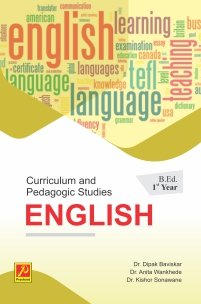Curriculum and Pedagogic Studies : ENGLISH
(B.Ed. First Year)
Authors:
ISBN:
₹325.00
- DESCRIPTION
- INDEX
1. Nature of Language :
1.1. Definition
1.2. Characteristics of Language
1.3. Principles of Language Learning
1.4. Place of English
A) In India With Special Reference To Three Language Formula B) In Maharashtra State C) In Present School Curriculum
1.5. Need and Importance of English Language
1.6. Halliday’s Seven Basic Functions of Language
1.7. General Objective of Teaching English
1.8. Instructional Objectives of Teaching English
2. Content-cum-Methodology :
2.1. Historical Perspective of Content-cum-Methodology
2.2. Meaning, Concept, Nature, Structure of Content-cum- Methodology
2.3. Scope of Content-cum-Methodology
2.4. Content analysis
2.5. Objectives of Content-cum-Methodology
2.6. Need and Importance of Content-cum-Methodology
2.7. Plan and Procedures of Content Cum Methodology
2.8. Implementation of Content-cum-Methodology
3. Developing Skills in CLT (Communicative Language Teaching) :
3.1. Listening Skill
A) Nature of Listening Skill B) Types of Listening Skill C) Procedures and techniques to develop listening skill D) Need and importance of listening skill
3.2. Speaking Skill
A) Nature, B) Process of teaching – speaking skill
C) Procedures and techniques to develop speaking skill
3.3. Reading Skill
A) Nature B) Types of Reading skill
3.4 Styles of Reading Skill
A) skimming B) scanning
3.5 Procedures and Techniques to Develop Reading Skill
3.6. Writing Skill-
A) Nature B) Types of writing
3.7 Procedures and Techniques to Developing Writing Skill
3.8. Nature of Skill Integration in Communicative Skills.
3.9. Procedures and Techniques to Develop Communicative Skills
4. Approaches, Methods and Techniques of Teaching and
Learning of English :
4.1. Meaning and concept of Approach, Method and Technique.
4.2. Difference between Method and Approach
4.3. Various methods evolved for Teaching English
4.4. Various Approaches evolved for Teaching – A) Structural Approach B) Communicative Approach C) Total Physical Response Approach (TPR)
4.5. Techniques /Devices
A) Note Making-Note Taking B) Storytelling C) Narration D) Dramatization
4.6. Support services
A) Language Laboratory B) Teaching aids: Audio, Visuals, Audio Visuals
5. Planning and Evaluation :
5.1. Types of Planning
A) Annual Plan B) Unit Plan C) Lesson plan
5.2. Construction of Unit Test- Blue Print
5.3. Types of Exams
A) Oral B) Written C) Practical.
5.4. Continuous comprehensive Evaluation System (CCE)
A) Concept of CCE. B) Objectives of CCE C) Features of CCE D) Functions D) Types E) Implementation
F) Advantages and Disadvantages of CCE.
6. Grammar and Usage :
6.1. Phonetics –
A) Vowels B) Diphthongs C) Consonants
6.2. Word Stress
6.3. Intonations
6.4. Kinds of Sentences-
A) Declarative sentence B) Imperative Sentence
C) Interrogative Sentence D) Exclamatory Sentence.
6.5. Types of Sentences- A) Simple Sentence B) Complex Sentence C) Compound Sentence D) Compound-Complex Sentences.
6.6. Parts of Speech
A) Noun B) Pronoun C) Verb D) Adverb E) Adjective
F) Preposition, G) Conjunction H) Interjection.
6.7. Application of Punctuations.
6.8. Auxiliaries and Modals
7. Teaching as a Profession :
7.1. Concept and Nature of Teaching profession
7.2. Difference between Occupation and Profession
7.3. Essential competencies of English Teacher
7.4. Characteristics of good English teacher
7.5. Concept of In-service, Pre-service Teacher Training Programmes
A) Concept of In-service Training Programme B) Pre-Service teacher training programmes
7.6. Training institutions for professional development of the English teacher with special reference to its nature, structure objectives and functions.
A) DCE B) State Institute of English Maharashtra (SIEM) C) The English and Foreign Language University (TEAFLU):
7.7. English Teacher Association
A) Nature B) Role of English Teacher Association
8. Learning Resources :
8.1. Print Resources: Print Resources for communicating verbal experiences:
A) Textbook B) Workbook C) Magazines D) Newspaper
E) Encyclopedia F) Instructional Material
8.2. Audio-visual aids
8.2.1 Audio Resources: A) Educational Radio Broadcast B) Non projected Visual Resources C) Projected visual resources
8.3. Innovative Resources
A) Library is a Learning Resources B) Social Networking Sites C) E-resources D) Computer-Assisted Language Learning (CALL) E) E-book
8.4. Advantages and disadvantages of Audio-visual aids
Related products
-
पालकत्व शिक्षण
₹160.00 -
पर्यावरण शिक्षण
₹180.00








